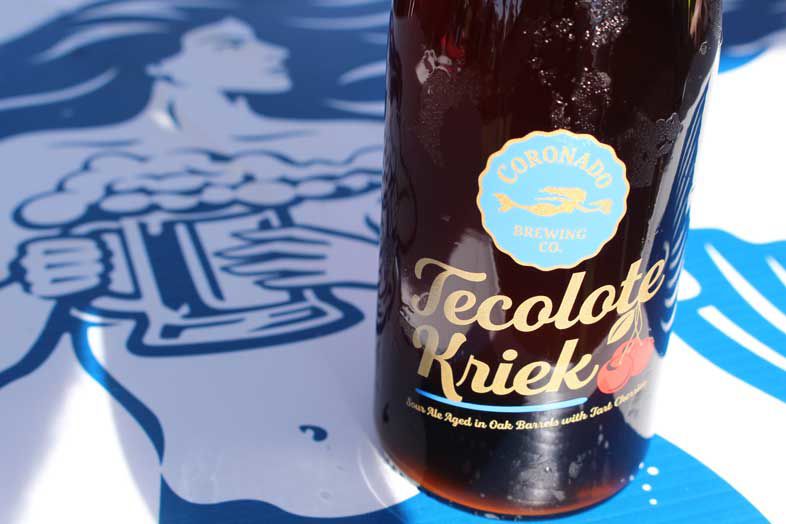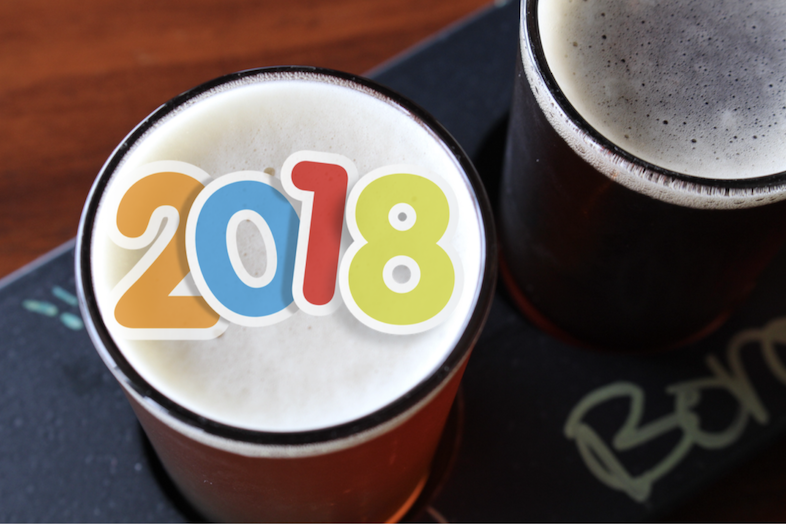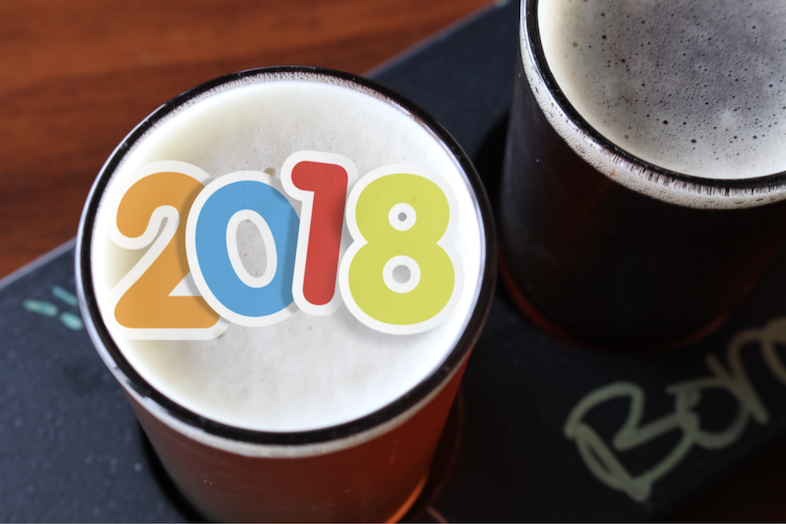Now that we’re squarely into the new year, it’s the perfect time to ask the obvious question: What made 2018 special? Like any year, it was a unique mix of new breweries opening and old breweries closing, of new styles taking hold and old styles holding steady, and lots of brewers working together to create unique and boundary-pushing brews that debuted, delighted, and disappeared, perhaps never again to be re-created.
The story of the San Diego beer scene is, by and large, an overwhelmingly positive one. Nevertheless, as the playing field expands and the players multiply, the inevitability of market contraction becomes clearer. In 2018—perhaps for the first time—we saw bankruptcies and closings from established breweries that took me (and many who closely watch the beer community) completely by surprise. Closings from less-seasoned breweries have peppered numerous years in the recent past, but the major business problems for companies like Green Flash, Toolbox, and Council last year were harsh reminders that any brewery can succumb to increasing pressures from the marketplace.
On the happier side, a bunch of very good new breweries made their mark on the San Diego scene last year—notable among them Northern Pine, Papa Marce’s Cerveceria, Melvin, Latchkey, and The Bell Marker—and numerous established breweries opened exciting new locations around town—like Eppig in Point Loma, Duck Foot downtown, and Amplified in East Village.
More than anything else in 2018, it was the beers themselves that made the year most satisfying. The big trends, like brut IPAs, hazy IPAs, Mexican lagers, and beer hybrids (combining beer ingredients with hard cider, wine, and mead) all produced consistently interesting and tasty results, as did the special collaborations that happened among San Diego brewers and also between San Diego and brewers from Baja (including the opening of SouthNorte in Tijuana at the Telefónica Gastro Park). Collaboration high points for 2018 include Stay Inland Wet-Hopped Brown from Nickel Beer and South Park Brewing, Blend-O-Matic Brut and Hazy IPAs from AleSmith and Second Chance, and Michulada Imperial Gose with cilantro, lemon, and sea salt from Karl Strauss and Thr3e Punk Ales.
No end-of-year wrap-up would be complete without a list of the beers that boldly stole the spotlight on their own. Of the hundreds of beers I tasted last year, here are 15 that truly wowed:
Tecolote Kriek (Coronado)
Meaty, malty, sour, and tart, this beer is amazingly complex and multi-layered. As the first kriek I tasted from Coronado Brewing (and one of only a few barrel sours from them) this beer, aged in oak with sour cherries, took me by surprise. It may be new, but it rivals some of the best-established barrel sours in town. (Watch out, Cable Car!)

The 15 Most Memorable Beers of 2018
Tecolote Kriek was one of 2018’s most pleasant beer surprises | Photo: Bruce Glassman
Glazed Imperial Stout (Burgeon):
This was one of the first real “pastry stouts” I tasted, and it was the aroma that really drew me in. This beer, made with actual donuts from VG Donut & Bakery, smelled like chocolate, malt, and coffee served from a box of freshly baked donuts. Medium bodied and slightly sweet on the finish, it still had enough heft and hops to keep it fresh and eminently drinkable.
Boneshakeur New Zealand Pilsner (Rouleur):
Brewer-Owner Rawley Macias absolutely nailed this technically challenging style perfectly, which was especially great to see, given the fact that many people initially considered Rouleur a Belgian-inspired house. This light and crisp lager had great depth of flavor; its classic, toasty breadiness was complemented by an extra bite from a healthy dose of citrusy, piney hops, giving it perfect balance and great sessionability.
Hidden Gem Dunkelweizen (OB Brewery):
Dunkels (dark wheat ales) are relatively few and far between in San Diego, so they tend to stand out. This dunkel—a Great American Beer Festival silver medal winner—distinguished itself with big banana and clove aromas and caramel maltiness, all enhanced by a subtle, slightly smoky backbone. Interesting and unique, this multilayered brew remained highly compatible with food.
Deftones Phantom Bride IPA (Belching Beaver):
In this town, when an IPA makes you sit up and take notice, it’s worth mentioning. With this offering—now in regular production—Belching Beaver has crafted an especially juicy IPA that showcases aromas and flavors of fresh citrus and pine wrapped around a beer with great body and just the right level of bitterness to keep it edgy.
Hazelnut & Rosemary Brown Ale (Second Chance):
Most beers with “sweet leaning” adjuncts like hazelnut can be tasty “sipping” beers, but aren’t great with food. This brown, however—expertly devised by brown-ale master Marty Mendiola—is a great food beer. Perfectly balanced so the beer flavors remain at the forefront, this brown is malty and slightly chocolatey, with just the right amount of rosemary to give it a bite, and the right amount of hazelnut to elevate the malt.
Faint of Tart (Bagby Beer):
This fruited blonde ale is a light-bodied beauty that’s bursting with tart juiciness from pomegranate, cherry, raspberry, and cranberry. You don’t see many fruited blondes in San Diego—I suspect because the lightness of the style means the fruiting level needs to be spot on—but brewing maestro Jeff Bagby knows how to get it just right. This beer is not only crazy crushable, it delivers an impressive amount of flavor for such a light, crisp, and clean style.
Pan a Flores (SouthNorte):
This special holiday porter blew my mind at Collabapalooza when I first tasted it. As I wrote in my holiday roundup, sipping this wonderful elixir, brewed with cajeta, cinnamon, Oaxacan coffee, and Mexican chocolate, is like wrapping yourself in a soft blanket by the fire pit. Dense aromas of cinnamon, vanilla, and nutmeg fill the glass, while rich flavors of chocolate, coffee, and cajeta round out this impressively mouth filling but not heavy beer.
Japanese Lager (Eppig):
It’s always nice to taste the specific contribution of a specific ingredient in a beer. In this case, the super-talented lager meisters at Eppig (Nathan Stephens and Clayton LeBlanc) used a strain of sake yeast that imparts a uniquely delicious rice-like sweetness to the finish. All of Eppig’s lagers are outstanding, but this brew stood out for its great concentration of flavor, its whisper of sweetness, and its remarkable crispness and balance.
Gin Gose (Owl Farms):
I first came across this beer at Rhythm & Brews in Vista. From the first sip I was truly impressed, not only with the adventurousness of the recipe, but also with how well the combination of elements worked. Gin and gose really complement each other! Up-front aromas of fresh fruit alongside the gin make this tangy beer really stand out, and special kudos go to Owl Farms for pushing the boundaries with new ideas and creative recipes.
We Have Issues Saison (The Bell Marker):
Okay, full disclosure: This was a collaboration between The Bell Marker and San Diego Magazine, so I had a hand in making this beer. Still, I believe I can be (mostly) impartial in assessing the results, which were delicious. This uniquely pink and hoppy saison—brewed with fresh blood orange and pomegranate and then generously dry hopped—was made possible only by the talents of brewer Ignacio “Nacho” Cervantes, who crafted a beer that was highly flavorful, perfectly balanced, and super easy to drink.
Festbier (Gordon Biersch):
I tasted a lot of great festbiers this year—we are fortunate to have so many San Diego brewers who can make them well—but the one that stood above the rest was created by master brewer Doug Hasker from Gordon Biersch. Doug’s complete mastery of all lager styles is without peer in this town, and his festbier—with its light body but thoroughly satisfying malt and subdued hoppiness—remains the benchmark for this style in San Diego.
Dwight Brut IPA (Duck Foot):
The Brut IPA craze that hit us at full speed last year inspired lots of brewers to try their hand at the technique (adding an enzyme that ferments out all the sugar and creates a completely dry finished product) and the results were very interesting. Most interesting was the fact that there were so many variations of bruts produced; they ranged from the super light all the way up to the IIPA range, depending on who made them. When I first tasted Dwight Brut, I was struck by its lightness and also its dryness; it made me think of a hoppy prosecco. Delicate but flavorful, this beer is a slam dunk for Champagne fans and is even more remarkable for its eye-poppingly low ABV of 3.5 percent.
Karl Strauss 29th Anniversary Saison (Karl Strauss):
You don’t see that many barrel-aged saisons in San Diego, which is a shame, because this is a style of beer that lends itself especially well to laying down. The anniversary release from Karl Strauss last year showcases the wonderful results one can achieve by barrel aging a great saison—especially if you do it in pinot noir barrels and add some Brettanomyces. The result is an immensely flavorful and complex beer, layered with dark fruit notes, spice, toasted bread, oak, and—of course—wonderful funk.
Tartistry Imperial Kettle Sour (Stone Liberty Station):
Every year, there’s at least one beer that turns my world on its head. Last year, it was the imperial kettle sour brewed by Kris Ketcham at Stone’s Liberty Station facility. It began with a simple description from Kris: “This is a Berliner-style beer that is augmented by the flavors of peanut and strawberry—kind of like a PB&J take on Berliner weisse.” My first thought upon hearing this description? No way! That’s crazy! But I’ll be gosh darned if the beer isn’t amazing. Special kudos to Kris for going where no other brewer has gone before.
Happy New Year, and here’s to tasting all that’s in store for 2019!

PARTNER CONTENT
The 15 Most Memorable Beers of 2018












